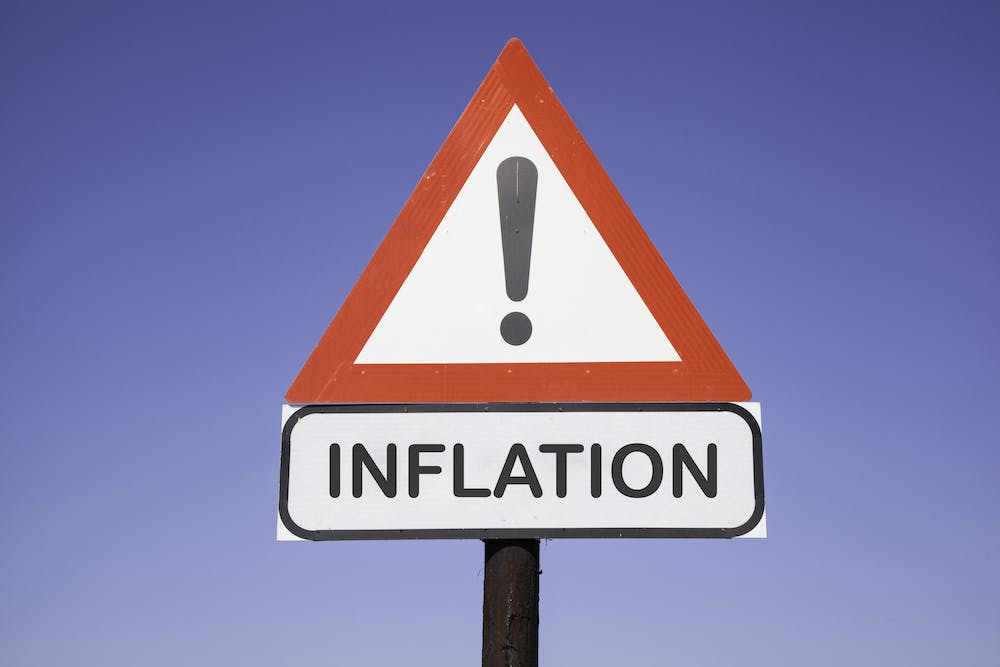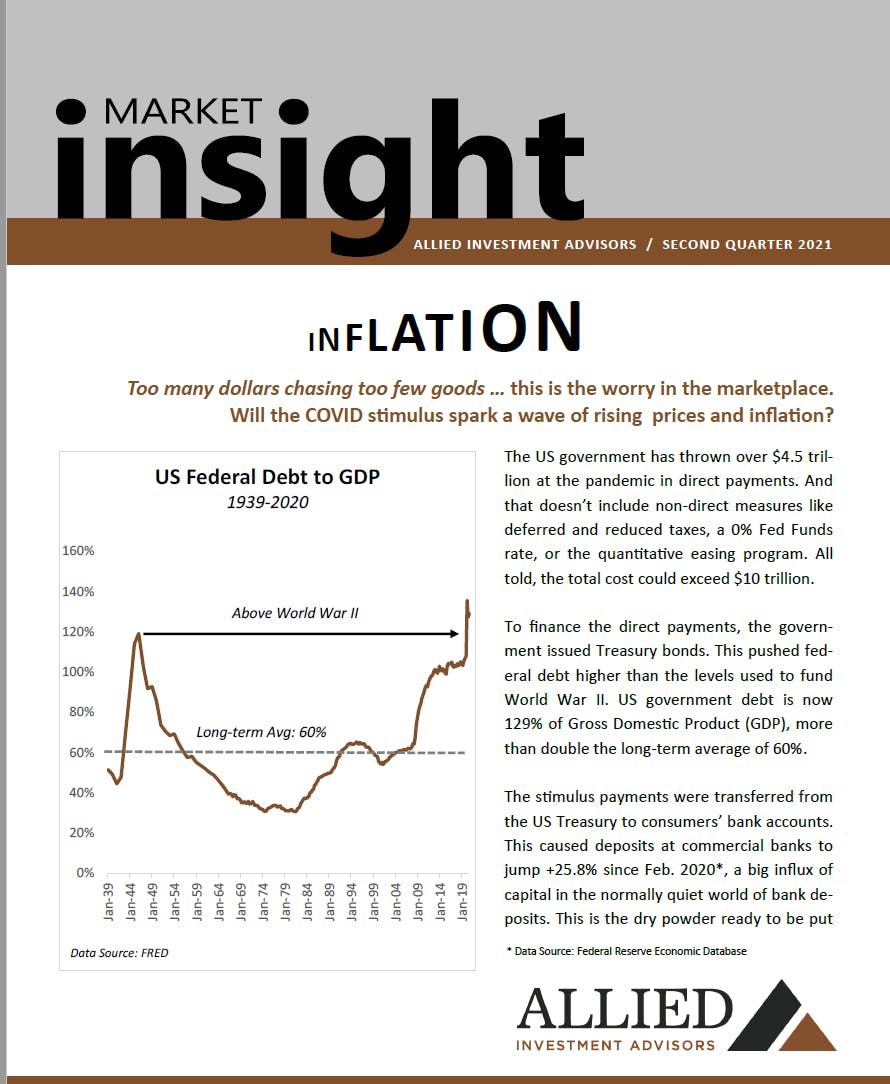Q2 2021: Inflation
May 12, 2021
Too many dollars chasing too few goods … this is the worry in the marketplace. Will the COVID stimulus spark a wave of rising prices and inflation?
The US government has thrown over $4.5 trillion at the pandemic in direct payments. And that doesn’t include non-direct measures like deferred and reduced taxes, a 0% Fed Funds rate, or the quantitative easing program. All told, the total cost could exceed $10 trillion.
To finance the direct payments, the government issued Treasury bonds. This pushed federal debt higher than the levels used to fund World War II. US government debt is now 129% of Gross Domestic Product (GDP), more than double the long-term average of 60%.

The stimulus payments were transferred from the US Treasury to consumers’ bank accounts. This caused deposits at commercial banks to jump +25.8% since Feb. 2020*, a big influx of capital in the normally quiet world of bank deposits. This is the dry powder ready to be put to work chasing those “too few goods.”
We’re already seeing some areas where this liquidity is causing rising prices. Lumber had been selling for $400 per thousand feet before the pandemic. Today it is up to $1,600/thousand – an increase of 300% in just over a year. Steel prices have seen a similar run-up. At the recent Berkshire Hathaway annual meeting, a company with over 80 operating subsidiaries spanning railroads to insurers to manufacturers, CEO Warren Buffett noted that, “We are seeing substantial inflation. We are raising prices. People are raising prices to us, and it’s being accepted.”
*Data Source: Federal Reserve Economic Database (FRED)

The Federal Reserve has an opposing view, saying current inflation is “transitory” – a short lived phenomenon that will pass as the COVID bottlenecks are cleared. They are focusing on keeping rates low to stimulate the economy and employment. The Fed is confident because, no matter how loose monetary policy has been over the last 30 plus years, they haven’t created any sustained inflation. Even after the large monetary stimulus of the Financial Crisis in 2007-09, when most analysts were predicting inflation, it didn’t materialize.
To get a better read on which camp is right, and more importantly to better position our portfolio for inflation risks, we went back and looked at market history to 1950.

On average, the market does its best at low to moderate levels of inflation. At any inflation level from negative (deflation) all the way up to 4%, the market had double-digit returns (or near double-digit returns in the 1% - 2% bracket). A healthy economy benefits the stock market, and does so without overheating into rapidly rising prices. This is the goldilocks scenario – where the economy is balanced just right.
As inflation heated to over 4%, returns came down, but they remained positive. In the 4% - 5% bracket, the S&P has a historical return of +3.1% per year. In the greater than 5% rise in prices bucket, the market still posted a +6.5% annual gain. While these are nominal returns (before inflation) and would come down once inflation was netted out (real returns), it’s not the investing disaster that many expect in a high inflation environment.
Digging deeper into the data, we also found that certain areas of the market hold up better in high inflation environments. We looked at sector data from S&P Global back to 1989 (as far back as sector data goes) and categorized it by inflation level.
In high inflation environments – CPI of over 4% per year – the best performing sectors were: Consumer Staples, Health Care, Communications, and Energy. The everyday essential products of Consumer Staples and Health Care are good ways to hedge against rising prices. The hard assets (oil and gas reserves) of Energy companies also provide a good hedge to rising prices. Communication Services used to be focused on telephone companies, which provided good inflation defense, but in recent years S&P reworked the Communications sector to include more discretionary names like Facebook, Google, and cable T.V. companies. We don’t have the data to say this segment will have the same inflation fighting characteristics going forward.
The worst performing sectors during high inflation have been Financials, Materials, and Technology. Both Financials and Technology are impacted by interest rates, which usually rise along with inflation. Technology companies often need low rates to justify their higher valuations. When rates rise, substitute investments look like better alternatives to the risks of growth investing, causing underperformance in the Tech sector. Financials on the other hand do very well in a rising inflation environment as higher interest rates help the big banks. That is, up until 4% inflation. After that, the market starts to worry about banks making loans today that will be paid back with inflated (lower value) dollars in the future.
Our portfolio positioning is tilted toward the better inflation hedge sectors and underweight some of the weaker sectors. Consumer Staples, Health Care, and Energy, in which we are overweight, have strong fundamentals, attractive valuations, and good dividends. We are also overweight in Financials, which we think will benefit from rising interest rates, even if it’s initially driven by inflation. The Technology and Consumer Discretionary sectors are less attractive based on valuations and signs of market euphoria, so we’re underweight.
We view our portfolio as having the best of both worlds: high-quality investments with good long-term potential – and an inflation hedge thrown in for free!
If you have any questions about your account(s), or if there has been a change in your financial situation or investment objectives, please feel free to contact any member of our team to schedule a meeting.
The views expressed in this newsletter represent the opinion of Allied Investment Advisors, a Registered Investment Adviser. This material is for informational purposes only. It does not constitute investment advice and is not intended as an endorsement of any specific investment or services. Nothing contained herein constitutes financial, legal, tax, or other advice. The information provided herein is obtained from sources believed to be reliable, but no representation or warranty is made as to its accuracy or completeness. Investing in equity securities involves risks, including the potential loss of principal. While equities may offer the potential for greater long-term growth than most debt securities, they generally have higher volatility. International investments may involve risk of capital loss from unfavorable fluctuation in currency values, from differences in generally accepted accounting principles, or from economic or political instability in other nations. Investment recommendations may change and readers are encouraged to check with their investment advisors before making any investment decisions. Past performance is not indicative of future results. Investments are not a deposit of or guaranteed by a bank or any bank affiliate. Please notify Allied Investment Advisors if there have been any changes to your financial situation or investment objectives or if you wish to impose or modify any reasonable restrictions on the management of your accounts through Allied Investment Advisors.

